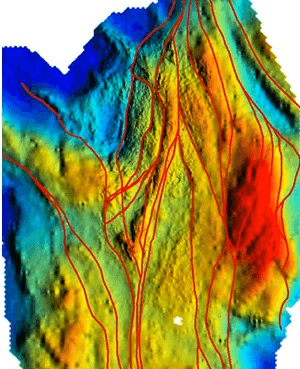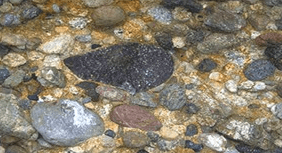 How to explore or “go prospecting” for a Orogenic-Mesothermal-Greenstone Gold Deposit is described herein starting with what exploration tool can be used? First is magnetic surveys can be very useful exploration tools, when looking for bends and structures that the potential host Greenstone/Orogenic shear hosted gold deposits and mineralization. Gravity surveys can be very successful in assisting mapping the geology areas where corps is particularly poor. It can also indicate where they may dense mafic are material hidden under a thin tectonic in placed slab on sediments or granites. For example in this gravity image of the greenstone belts in western Australia, you can see in the area of very dense rocks in red, with a surface mapping, a part of this area show lower density sandstones.
How to explore or “go prospecting” for a Orogenic-Mesothermal-Greenstone Gold Deposit is described herein starting with what exploration tool can be used? First is magnetic surveys can be very useful exploration tools, when looking for bends and structures that the potential host Greenstone/Orogenic shear hosted gold deposits and mineralization. Gravity surveys can be very successful in assisting mapping the geology areas where corps is particularly poor. It can also indicate where they may dense mafic are material hidden under a thin tectonic in placed slab on sediments or granites. For example in this gravity image of the greenstone belts in western Australia, you can see in the area of very dense rocks in red, with a surface mapping, a part of this area show lower density sandstones.
This indicates that there as to be a thick package of dense mafic and ultramafic for volcanic like lying underneath the sandstones. Magnetics can also to be used to identify magnetite enrichment in the rocks possible signifying that the oxidizing fluids are pass through them. Some areas of apparent hydrothermal magnetite are circled in yellow. Obviously geological mapping is a critical part of any exploration effort.
And the identification of the late stage conglomerates like those in the photo, can give a further clue as to where the deep tapping structures may occur.  Seismic surveys previously largely restricted to the oil industry are been increasingly used in greenstone terrain, because of the small differences in seismic velocity of various Greenstone/Orogenic belt rocks. It usually to be thought that seismic wouldn’t be practical. However with the improve fiber sized techniques and computing power to interpret the data.
Seismic surveys previously largely restricted to the oil industry are been increasingly used in greenstone terrain, because of the small differences in seismic velocity of various Greenstone/Orogenic belt rocks. It usually to be thought that seismic wouldn’t be practical. However with the improve fiber sized techniques and computing power to interpret the data.
The seismic can reveal much of the deep structure of the crust to skill interpreters. Combining seismic profiles or shooting 3D Seismic survey can allow 3D models of the entire greenstone belts to be built. Extending down to the base of the crust. This allows explorist to identify the key structures that are likely to have acted as channel ways from the partially melting lower-crust to potential shallow gold traps.
Once the areas potential interest of being identified, the process focus on these, using various grounds exploration techniques. Detail ground magnetics maybe collected to prove the resolution of the earlier air borne magnetic surveys. Induced polarization (IP) were also provide valuable information on the sulfide or solicitation that’s associated with the quartz veins stock works, with IP a pulse of current is sent into the ground under the cave of the wave form due to sulfide retaining an induced charged is measured. The picture shows that a winter survey on the way in Colombia and the generator that produces the initial current can be seen in the bottom left. Unfortunately because my minuet concentration gold cannot be detected directly by any geophysical techniques available today.
However geo chemistry plays a vital part both in soil sample survey and the collection of grab samples during exploration. In addition to attain for gold directly, so-called pathfinder elements that are associated with the gold such as silver, arsenic and tungsten are also commonly used here are the results of a soil geochemical survey. This is the row of colored circle, super impose on the back ground geology and magnetics
The soil sample show hotter colors for higher grades and outline are clear golden soil anomaly in the north central part of this grid in Tanzania.
 Inevitably geophysical and geochemical targets needed to be tested by drilling. And this shows the same sort of anomaly be drilled tested with an RC rig. Some the issue of exploration in third world can be clearly seen with curious onlookers and life stock arriving to see what’s going on.
Inevitably geophysical and geochemical targets needed to be tested by drilling. And this shows the same sort of anomaly be drilled tested with an RC rig. Some the issue of exploration in third world can be clearly seen with curious onlookers and life stock arriving to see what’s going on.
To complete this I will finish with a couple of slides illustrating how once they have proven to be economic these mesothermals veins can be physically mined. The traditional method of mining them from underground was using either shrinkage stoping or cut and fill stoping. The cut away diagram shows shrinking stoping, where drifted is developed along the ore body and then another one is developed parallel and use as a transport drifted and that lies in the foot wall to the veins. The vein is then progressively blasted upwards with the mining standing on pile of blasted ore drill each success of blast. The broken ore is drawn out from bottom of the slope to make space for the drillers. This photo shows the view in one of these shrinking stops with the blasted ore forming the floor to the tunnel.
However on the ground stoping is slow and expensive. If the vein is thick or there is a dense enough clustering the veins open pit mining might be more economical way to extract that ore. This is particular the case in shallow oxide ore where the grade maybe smeared into the wall rocks. The rock is soft mined and cheaply process. Here you can see the giant Kalgoorlie super pit be mining in Western Australia.
You can also see where red oxide ore gives way to the underline grey primary ore at depth. That then is a quick summary of Greenstone/Orogenic shear hosted gold deposits. One of the critical learning points you should walk away with from this talk. Well greenstones shears hosted gold deposits are an important source of gold and there are lots of juniors out looking for them.
The vein deposits, they are often high grade but tend to be low tonnage, most significant producers are in east Canada, Western Australia, eastern West Africa and Brazil. They have high grade ore shoots in them, those have a good vertical continuity but generally have very short strike length, and about ten to twenty percent of deposits are refractory. In other words difficult to get the ore out of and expensive to treat.
